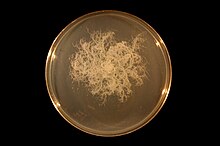Bacillus mycoides is a bacterium of the genus Bacillus. Like other Bacillus species, B. mycoides is Gram positive, rod-shaped, and forms spores. B. mycoides is distinguished from other Bacillus species by its unusual growth on agar plates, where it forms expansive hairy colonies with characteristic swirls.
| Bacillus mycoides | |
|---|---|

| |
| Bacillus mycoides growing clockwise on an agar plate. | |
| Scientific classification | |
| Domain: | Bacteria |
| Phylum: | Bacillota |
| Class: | Bacilli |
| Order: | Bacillales |
| Family: | Bacillaceae |
| Genus: | Bacillus |
| Species: | B. mycoides
|
| Binomial name | |
| Bacillus mycoides Flügge 1886
| |
| Synonyms | |
|
Bacillus weihenstephanensis | |
Description edit
B. mycoides are rod-shaped cells about 1 micron across and 3 to 5 microns long. When growing, they either grow as single cells or form loosely connected chains of cells.[1] They are not motile. B. mycoides can survive with or without oxygen and grows at temperatures ranging from 10 to 15 °C to 35–40 °C.[1] B. mycoides is distinguished from a number of other Bacillus species in the unusual morphology of the colonies it forms when grown on agar plates. B. mycoides forms white opaque colonies that are characteristically hairy in appearance (often referred to as "rhizoid").[1] These colonies rapidly spread to fill the plate and are characterized by a repeating spiral pattern.[1][2] B. mycoides has the unusual property of being able to respond to mechanical force and surface structure variations in the media on which it is growing.[3]
Ecology and distribution edit
B. mycoides is present in a wide variety of environments, especially soil.[1]
Role in disease edit
B. mycoides are capable of causing disease in some fish, and were the reported cause of an outbreak of necrotic lesions in channel catfish in a commercial pond in Alabama.[1]
B. weihenstephanensis edit
In 1998 a new Bacillis species was described, and named Bacillus weihenstephanensis.[4] However, twenty years later, a comparison of the complete genome sequences of B. weihenstephanensis and B. mycoides demonstrated that B. weihenstephanensis was a later synonym for B. mycoides, and thus not a valid species, nor species name.[5]
References edit
- ^ a b c d e f Logan NA, De Vos P (2015). "Bacillus". In Whitman WB (ed.). Bergey's Manual of Systematics of Archaea and Bacteria. John Wiley & Sons. pp. 1–163. doi:10.1002/9781118960608.gbm00530. ISBN 9781118960608.
- ^ Di Franco, C., Beccari, E., Santini, T., Pisaneschi, G., & Tecce, G. 2002. Colony shape as a genetic trait in the pattern-forming Bacillus mycoides. BMC Microbiol. 2, 33.
- ^ Stratford, JP; Woodley, MA; Park, S (2013). "Variation in the Morphology of Bacillus mycoides Due to Applied Force and Substrate Structure". PLOS ONE. 8 (12): e81549. Bibcode:2013PLoSO...881549S. doi:10.1371/journal.pone.0081549. PMC 3855686. PMID 24324702.
- ^ Lechner, Sabine; Scherer, Siegfrie; et al. (1998). "Bacillus weihenstephanensis sp. nov. is a new psychrotolerant species of the Bacillus cereus group". International Journal of Systematic Bacteriology. 48 (4). Microbiology Society: 1373–1382. doi:10.1099/00207713-48-4-1373. ISSN 0020-7713. PMID 9828439.
- ^ Liu, Yang; Lai, Qiliang; Shao, Zongze (1 January 2018). "Genome analysis-based reclassification of Bacillus weihenstephanensis as a later heterotypic synonym of Bacillus mycoides". International Journal of Systematic and Evolutionary Microbiology. 68 (1): 106–112. doi:10.1099/ijsem.0.002466. PMID 29095136.
Further reading edit
- Lin, Hong-Yan; Yu, Chang-Ping; Chen, Zu-Liang (February 16, 2012). "Aerobic and anaerobic biodegradation of TNT by newly isolated Bacillus mycoides". Ecological Engineering.
- Soufiane, Brahim; Cote, Jean-Charles (March 12, 2013). "Bacillus weihenstephanensis characteristics are present in Bacillus cereus and Bacillus mycoides strains". FEMS Microbiology Letters. 341 (2): 127–137. doi:10.1111/1574-6968.12106. PMID 23413955.
External links edit